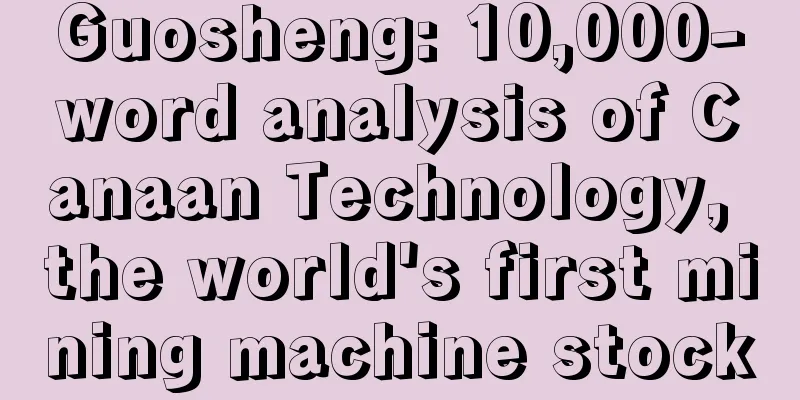Guosheng: 10,000-word analysis of Canaan Technology, the world's first mining machine stock

|
Original title: "Guosheng Communications Song Jiaji | Canaan Technology in Depth: The world's first mining machine stock, industry extension looks at AI" Seize the historical opportunity of Bitcoin to build a strong mining machine team and extend to the AI market in the future. Canaan Creative was founded in 2013 and has become the world's leading supercomputer chip design manufacturer, blockchain computing equipment manufacturer, and digital blockchain computing software and hardware overall solution provider. The company's main business is the design and sales of AvalonMiner brand mining machine chips, providing chip design and system products and solutions for the global Bitcoin network "mining". In addition, the company is driven by the pursuit of breakthrough design ideas and the pursuit of cutting-edge technology, and uses high-performance ASIC chip design capabilities as a weapon to extend its products and services to artificial intelligence solutions through integrated solutions. Mining machines can be regarded as a "call option" on the price of Bitcoin, and the industry threshold is relatively high. When miners buy mining machines, they obtain a relatively certain number of Bitcoins in the future at a certain price. The idea of miners buying mining machines comes from their expectation that the price of Bitcoin in the future will be higher than it is now, resulting in "expected mining income" higher than the current mining income, bringing excess income. It is equivalent to miners being able to buy Bitcoin at a price lower than the market price in the future. Mining machines can be regarded as a "call option" on the price of the currency. The mainstream Bitcoin mining machine suppliers adopt the fabless model, and their own competitive advantages are mainly reflected in the design of ASIC mining machine chips. ASIC chip design belongs to the high-tech industry, which requires companies to be able to launch better-performing generation products in a timely manner according to the market. Therefore, it has a relatively high entry threshold for companies' R&D capabilities, capital investment, supply chain management, and financing capabilities. The company has mastered high-performance computing chips and deployed artificial intelligence chips. The company continues to launch chip products with updated computing power and faster iterations, and continues to lead the industry. In 2018, the world's first 7nm chip was launched. After two years of research and development, Canaan has not only made evolutions and breakthroughs in chip research and development and hardware manufacturing, but also used chips as a strategy combined with supporting software management systems and solutions to inject diversified applications into the field of artificial intelligence; providing another market strategy for edge computing, and creating a new era of artificial intelligence with developers. As of September 30, 2019, the company has delivered more than 53,000 chips and development modules to AI product developers, and has cooperated with more than 30 AI algorithm companies to develop overall AI solutions for end consumers, and continuously promote its expansion in the AI market. Profit forecast and investment advice. Unlike ordinary electronic products, mining machines are not priced at cost, but fluctuate with the spot price of BTC. Combined with the halving expectations and computing power share in 2020, we predict that the company's gross profit in 2019-2021 will be 240 million yuan, 620 million yuan, and 1.45 billion yuan, respectively, and the net profit will be 42.06 million yuan, 197 million yuan, and 807 million yuan, respectively, and the EBITDA will be 104 million yuan, 342 million yuan, and 1.145 billion yuan, respectively. We use EV/EBITDA to value the company. The average market value/EBITDA of comparable companies in the same industry in 2020 was 27.99. We expect the company's EBITDA in 2020 to be 342 million yuan. If the valuation is based on the industry average, based on the company's scarcity position and earnings elasticity, we cover it for the first time with a target price of US$12.04/ADS (75.66 yuan/ADS corresponds to 35 times EV/EBITDA in 2020). Risk warning: 1. Occurrence of cryptocurrency-related risk events; 2. Project technology progress and application implementation are not as expected; 3. Regulatory policies are uncertain. 1. Industry-leading mining chip design and manufacturerFounded in 2013, Canaan Creative is the world's leading supercomputer chip design company, blockchain computing equipment manufacturer, and digital blockchain computing software and hardware overall solution provider. The company's main business is the design and sales of AvalonMiner brand mining machine chips, providing chip design and system products and solutions for the global Bitcoin network "mining". In addition, the company is driven by the pursuit of breakthrough design ideas and the pursuit of cutting-edge technology, and uses high-performance ASIC chip design capabilities as a weapon to extend its products and services to artificial intelligence solutions through integrated solutions. The company is registered in the Cayman Islands holding company and conducts business through its Chinese subsidiary, Hangzhou Canaan Creative Information Technology Co., Ltd. 1.1 Leader in ASIC chip design industryThe company is a leader in the ASIC chip design industry. Its main businesses include AvalonMiner brand cryptocurrency mining machine chip design, whole machine supply and sales, and industry solutions. The company develops its own IC chips, which are manufactured, packaged, and tested by leading semiconductor manufacturing companies in the industry (TSMC, Samsung STATS ChipPac, ASE, and SPIL, etc.), and finally the company completes the whole machine assembly and product sales. Its downstream customers are Bitcoin "miners". Relying on powerful system computing power, excellent energy efficiency ratio, and high reliability, the company's products have been widely recognized by the market. Specific services include: Cryptocurrency system products (mining machines): The company's Avalon custom server (AvalonMiner) is the world's leading cryptocurrency mining machine brand. Its products are sold to more than 60 countries and regions around the world, and the ASIC chips built by this product are all independently developed by Canaan Creative. So far, Avalon custom servers have undergone 12 iterations, and their performance continues to lead the industry. The price of bitcoin fell in 2018, and the computing power was out of sync with the price of bitcoin, which led to fluctuations in industry operations. In 2018, the price of bitcoin fell rapidly, and the bitcoin market entered a bear market, but the computing power continued to grow from January to November. In November, the computing power began to retreat, and then entered a period of shock. The slowdown in the growth of computing power is the main reason for the decline in performance of the entire mining machine industry. In December 2017, the price of bitcoin hit a record high, approaching $20,000, and then took a sharp turn. In November 2018, it fell to about $6,000, but during this period, the computing power of the entire Bitcoin network has been rising. It was not until November 2018, when the low point of $6,000 appeared, that the computing power of Bitcoin began to decline, showing that the computing power and the price of the currency were not completely synchronized. This is mainly due to the conversion of hydropower in southwest China, the rigidity of the electricity cost of the mine (bottom line agreement), and the low cost of a considerable number of miners. In 2019, the computing power first declined and then rose, and the performance of the mining machine industry fluctuated. The global Bitcoin mining machine market is relatively concentrated in a few large competitors. Most of the leading industry competitors are in China. According to Frost & Sullivan, Canaan Creative is currently the world's second largest Bitcoin mining machine supplier, accounting for nearly 20% of the market share. Currently, the market is dominated by Bitmain and Canaan Creative. Bitcoin mining machines are the company's main source of revenue. In the first half of 2019, the industry was greatly affected by the fluctuations in the currency market, computing power market and the mass production capacity of new products. It is expected that the performance will stabilize in the second half of the year. In recent years, the company's revenue is mainly based on Bitcoin mining machines, accounting for more than 99%. From 2017 to 2018 and the first half of 2019, the company's revenue was 1.308 billion yuan, 2.705 billion yuan, and 289 million yuan respectively; net profit was 376 million yuan, 57.2 million yuan, and -314 million yuan respectively. In terms of gross profit margin, Bitcoin was in a bull market in 2017, the mining machine market was booming, and the company's mature products quickly occupied the market, so the gross profit margin was as high as 46.2%; in August 2018, the company launched the world's first 7nm ASIC chip. The research and development of the latest process chip is conducive to the company's industry leadership, but the initial cost investment in chip research and development and tape-out is large. In the context of the bear market, the company's gross profit margin continued to decline, and the gross profit margin in the first half of 2019 was 3.88%. In the third quarter of 2019, the company achieved revenue of 670 million yuan (+40%) and net profit of 91.14 million yuan, turning losses into profits compared with the same period last year. With the steady growth of currency prices and computing power, the company's performance is expected to accelerate. The company has excellent management, strong R&D capabilities and a stable team. The company's management has complementary expertise in IC design and manufacturing as well as software development. Under the leadership of Chairman Zhang Nangeng, the company's core team is stable and grows with the company; as of June 30, 2019, the company has a 127-member R&D team, accounting for approximately 44.4% of the total number of employees, with an average of 7 years of industry experience, of which 61 have a master's degree or above. Relying on strong R&D capabilities, the company's strategy and development are supported. The company was recognized as a high-tech enterprise by the Ministry of Finance and the State Administration of Taxation from 2016 to 2018. The company's main management holds more than 50% of the shares, and the equity structure is stable. The company's management holds 50.8% of the shares, of which Li Jiaxuan, Zhang Nangeng, Kong Jianping, and Sun Qifeng hold 16.2%, 16.0%, 12.1%, and 5.8% of the shares respectively. The equity structure is stable, and the founding team and core team have grown together with the company for many years, laying the foundation for the company's stable development. Among them, the company's founder Zhang Nangeng owns 74% of the company's voting rights, paving the way for the company to concentrate resources and form a joint force to build a chip powerhouse. 1.2 Follow the industry growth and build a leading mining machine companyThe emergence of new technologies such as artificial intelligence, big data, cloud computing and blockchain has driven the rapid growth of the ASIC chip industry. Due to the ability of ASIC chips to perform calculations repeatedly and their high energy efficiency ratio, they have outstanding advantages in applications such as blockchain, cryptocurrency mining, edge computing, and machine learning. According to Frost & Sullivan, the market size of the global Bitcoin mining machine industry increased from RMB 1.1 billion in 2014 to RMB 21.4 billion in 2018, with a compound annual growth rate of 110.0%. In the next five years, the market size of the global Bitcoin mining machine market is expected to reach RMB 31.7 billion in 2023, with a compound annual growth rate of 8.2%. Especially in recent years, the blockchain and cryptocurrency mining industries have developed rapidly, and driven by the rapidly expanding demand, the design, production and sales of blockchain mining machine chips have entered a period of rapid growth. The six years since the company was founded are the period of rapid development of the blockchain industry. The company has successfully seized the opportunity and quickly grown into an industry leader. Based on blockchain mining machines, the company has extended to broader fields such as AI and IC to build a strong mining machine team and a chip powerhouse. The future development strategy is:
The company plans to list on Nasdaq by issuing ADS. As of the date of the prospectus, the company has issued 2.22 billion common shares (of which 52.027 million shares are restricted shares), including Class A common shares and Class B common shares (all 356,624,444 Class B shares are held by Zhang Nangeng). Among them, each Class A common share has 1 vote, and each Class B common share has 15 votes. The funds raised will be used for the research and development of ASIC chips related to AI algorithms and applications, the research and development of ASIC chips related to blockchain algorithms and applications, and the expansion of AI and blockchain businesses worldwide through strategic investments and the establishment of overseas offices, and the optimization of supply chains. 2. Bitcoin Mining Machine: The Trust Foundation and Value Barrier of "Digital Gold"2.1 Building consensus on "digital gold", Bitcoin promotes the mining industryBitcoin is gathering consensus on "digital gold". 11 years ago, Satoshi Nakamoto published the Bitcoin white paper, which opened up the blockchain digital asset wave and the wealth revolution that subverted social cognition; in 2010, it was reported that a programmer "bought" 2 pizzas with 10,000 Bitcoins. In 2013, as the price of Bitcoin exceeded $1,000, Bitcoin enthusiasts from all over the world participated in Bitcoin "mining". Today, 6 years later, the price of Bitcoin exceeds $8,000 per coin (it was close to $20,000 per coin at the end of 2017). Bitcoin initially went from a "currency game" for niche geeks to "digital gold" with huge price fluctuations, creating a wealth legend spanning ten years; today, the consensus on "digital gold" has been initially established, and a futures market has been established on traditional financial trading platforms (represented by the Chicago Mercantile Exchange (CME) and the Chicago Board Options Exchange (COBE) in the United States). There is no doubt that Bitcoin has begun to enter the mainstream market. The underlying Bitcoin ledger uses blockchain technology, and then blockchain has become synonymous with the industry. Blockchain is a distributed ledger that combines data blocks into a chain data structure in chronological order and guarantees that it cannot be tampered with or forged by cryptography. Simply put, if you want a completely peer-to-peer payment/exchange market (this market does not require any intermediary institutions, such as banks, service intermediaries, etc.), blockchain can provide a decentralized accounting solution. Taking payment transfer as an example, the traditional payment transfer system requires a bank as a third party (corresponding to the concepts of "centralization" and "third-party trust endorsement") to transfer the corresponding amount according to the request made by the two parties to the transaction - that is, to change the account balances under the names of both parties in the database. In this process, the accounting right belongs entirely to the bank. In the payment transfer system equipped with blockchain technology, users can directly conduct peer-to-peer transactions (corresponding to the concept of "decentralization"). There is no need for a centralized institution to keep accounts for users. Instead, every user in the system can participate in the competition for accounting according to specific rules. In a certain period of time, the user who competes for the right to keep accounts writes the transactions during this period into a block, just like writing to a page of accounts. After other users in the system confirm that the account page is not a fake account, they back it up and complete the entire operation. In the next time period, the cycle repeats, and each block is connected end to end to form a complete chain. Through the principles of cryptography, the order and timestamp of the blockchain naturally form anti-tampering protection. Since there is no centralized organization, blockchain runs automatically according to pre-set programs, which can greatly reduce costs and improve efficiency, and ensure that the data recording process and results are open and transparent. In addition to payment transactions, blockchain can also be used in broader fields, such as medical care, supply chain management, the Internet of Things, security authentication, social networking, and artificial intelligence, which will have a profound impact on social structure. Point-to-point value transfer, blockchain leads the future "value Internet". The advent of the Internet era has broken the barriers of people in point-to-point information transfer, and the emergence of blockchain technology has enabled the Internet to not only serve as a carrier of point-to-point information, but also point-to-point value transfer. On October 31, 2008, a network ID named "Satoshi Nakamoto" published a 9-page Bitcoin whitepaper, titled "Bitcoin: A Peer-to-Peer Electronic Cash System", which brought a decentralized electronic cash application solution to human society for the first time. When designing Bitcoin, Satoshi Nakamoto followed the laws of economics. Bitcoin is an electronic cash system, or in other words, Bitcoin itself is a decentralized, peer-to-peer accounting system for electronic cash. The Bitcoin network is the first payment transaction system that successfully applied blockchain technology. Without the credit endorsement of a centralized institution, the "trust value" of the system is created by its encryption algorithm and consensus mechanism. At the same time, Satoshi Nakamoto brilliantly introduced the first blockchain token, Bitcoin (Bitcoin, here Bitcoin refers to the tradable coin, not the network system of the same name). The token is the only wealth expression of the system - to transfer electronic cash (Bitcoin) in the Bitcoin network, Bitcoin needs to be paid as a handling fee. The computer computing resources that support the safe and reliable operation of the network are provided by miners, and the handling fees and a fixed number of newly issued bitcoins are paid to miners as rewards - this process is called mining. The "mining" behavior encourages more network nodes to join in and provide computing resources for the system; at the same time, the "six block confirmation" mechanism ensures that the current block will be confirmed 6 times by subsequent blocks to avoid "false accounts" and maintain and increase the "trust value" of the system. Bitcoin mining, in one sentence, is "fighting for the system's accounting rights and obtaining Bitcoin as a reward" - it is both a process of fighting for accounting rights and a process of issuing Bitcoin. To expand the concept specifically, you need to know "how to mine" (PoW consensus mechanism) and "what to mine" (incentive mechanism). Bitcoin mining follows the market competition mechanism of computing power. The mechanism of Bitcoin mining is the PoW consensus mechanism, that is, the Proof of Work mechanism, which is the "rules of the game" for users to compete for the right to keep accounts. Simply put, miners compete freely through computing power, and the one with the strongest computing power can win the right to keep accounts, generate the latest blocks on the chain, and obtain tokens (here is Bitcoin) as rewards. It ensures that the huge distributed network can reach a consensus. At the same time, because users have to pay a price (computing resources and time) to win the right to keep accounts, the PoW consensus mechanism also limits the noise and intentional attacks in the network, ensuring the security of the network. Bitcoin mining machines are essentially computers that provide physical computing resources for the system and are the cornerstone of value interconnection. As the price of Bitcoin and the blockchain network continue to grow, computing power provides physical resource support for the system. This is also the reason why Bitcoin's ledger has never had any errors or been successfully attacked in the past 10 years. Specifically, the current mainstream Bitcoin mining machines are mainly composed of the following parts: computing boards containing computing chips and heat sinks, fans, controller circuit boards, aluminum alloy shells, and external power supplies. The most core component here is the computing chip. The computing performance and power consumption of the mining machine are determined by the computing chip, and its cost accounts for about 80% of the total manufacturing cost of the mining machine. "Power consumption per unit of computing power" is the core indicator for evaluating the performance of mining machines. Under the same computing power, the lower the power consumption of the mining machine, the better the performance of the mining machine. The so-called "power consumption per unit of computing power" is the power consumption/computing power of the mining machine. With the overall improvement of the computing power of the entire network, it will become more and more difficult to successfully mine. Therefore, mining machines need to be replaced regularly to maintain the original income. In recent years, mainstream manufacturers usually upgrade their product series once a year, and may release updated versions to fine-tune performance, power consumption, and price according to market conditions. In this process, the computing power of a single mining machine is constantly improving, while the core indicator "power consumption per unit of computing power" is constantly decreasing. To optimize the "power consumption per unit of computing power", it is necessary to replace general-purpose chips with special-purpose chips. The development of Bitcoin mining machine chips has gone through four stages from CPU, GPU, FPGA to ASIC. In this process, the chips that provide computing power have gradually shifted from general-purpose to mining-specific chips. The so-called ASIC chip (Application-Specific-Integrated-Circuit chip) refers to an integrated circuit designed for a specific purpose. The characteristics of ASIC are that it is oriented to specific algorithm requirements. Compared with general-purpose integrated circuits, it has the characteristics of smaller size, lower power consumption, improved reliability and lower unit cost in mass production. Bitcoin mining is a repetitive calculation under a specific algorithm, so the application of ASIC solutions will greatly improve chip performance. 2.2 Chip design has a high entry barrier and requires rapid R&D iteration to maintain competitive advantageThe mainstream Bitcoin mining machine suppliers adopt the fabless model. Their competitive advantage is mainly reflected in the design of ASIC mining machine chips. ASIC chip design belongs to the high-tech industry, which requires companies to be able to launch better-performing generation products in a timely manner according to the market. Therefore, it has a relatively high entry threshold for the company's R&D capabilities and capital investment. Companies need to have the following resources to stand out in this industry: 1) Strong R&D capabilities. In view of the continuous growth of the computing power of the entire network in the downstream mining industry, upstream ASIC mining machine chip designers need to be able to adapt to the market with rapid product changes. Only by continuously launching more cost-effective products at an industry-leading speed can we seize the market opportunities of similar new products, obtain corresponding premiums and more customer favors. At the same time, fast and effective R&D capabilities can also reduce the number of failures of enterprises in R&D, thereby reducing unnecessary R&D costs. All of this requires chip designers to have a strong R&D team, years of R&D experience and accumulated R&D data. 2) Strong capital guarantee. Chip design has the characteristics of large initial investment and long cycle, so companies need to invest a lot of R&D funds in the early stage and be able to bear the potential losses caused by it. This puts certain threshold requirements on the company's current assets and cash flow. 3) Good cooperative relationship with upstream high-quality foundries. Only the most efficient ASIC miners can be favored by the market, and in the foundry's production process, the process technology used by the mining machine chip has a critical impact on its performance. Given the limited production capacity of high-end process technology lines, only when the company's orders are given priority to be executed by the foundry can the company's latest products enter the market in a timely manner and seize the initiative. Therefore, it is necessary for the company to maintain a good cooperative relationship with high-quality foundries, and this resource is usually not available to potential entrants. 4) Economies of scale. Generally speaking, the hardware cost of a chip = (wafer cost + test cost + packaging cost + mask cost) / final yield rate. Efficient ASIC chips require the application of the most advanced process technology, and when the latest process technology first came out, the mask cost was quite expensive, up to one billion US dollars (mature process technology may only cost a few million US dollars). Only after the company has achieved economies of scale can the mask cost be shared, so that the unit cost can be reduced and the cost advantage of the product can be formed. The industry is in a period of chaos among several giants. At present, the market participants of ASIC-based Bitcoin mining machines are mainly concentrated in several giants in the industry, and the vast majority of leading companies are located in China. According to Frost & Sullivan, in the first half of 2019, Canaan ranked second in the world (China) in terms of shipments and total share of computing power of ASIC-based Bitcoin mining machine manufacturers. As of June 30, 2019, the company's market share in computing power was 21.9%, up from 15.3% in the same period of 2018, and the market share of Bitcoin mining machine shipments was 23.3%. The future competition landscape of the Bitcoin mining machine industry will remain unchanged, and the two leading companies are superior to other companies in terms of core resources. Through product comparison, we can find that the market leaders Bitmain and Canaan Creative have advantages in the two core parameters of their products ("power consumption per unit computing power" and "price per unit computing power"). The continuous replacement of new products every year also proves the sustainability of the research and development capabilities of these two companies; in comparison, other mining machine suppliers may have problems such as insufficient scale effect, overpriced products, and insufficient series development capabilities. 2.3 The financial nature of mining machines: the “call option” of currency pricesThe mining industry has formed a clear industrial chain and ecosystem: (1) Mining machine manufacturers are the original suppliers of computing power. Miners use legal currency to purchase mining machines from mining machine manufacturers to obtain computing power; (2) Mining farms are the physical hosting places for computing power. Miners host their mining machines in mining farms (mainly distributed in northwest and southwest China); (3) Miners can choose to directly connect their computing power to mining pools or sell them to cloud computing power platforms. Among them, 1) the function of mining pools is to aggregate miners' computing power and guarantee miners' income; 2) the role of cloud computing power platforms is to recover funds for miners. In practice, mainstream mining machine manufacturers and mining farms charge fiat currency (some illegal mining farms charge cryptocurrencies to avoid taxes), and cloud computing power platforms charge computing power products in fiat currency, but for convenience and compliance reasons, some cloud computing power platforms actually charge cryptocurrencies. In general, fiat currency is still the means of payment in the mining industry chain, and cryptocurrencies only exist as mining income. The participants in the Bitcoin-related value chain are as follows: the upstream is the design, production, testing, packaging and sales of mining machines; the midstream is the mining pools and mining farms; the downstream is Bitcoin exchanges and wallets. The upstream provides mining machines for Bitcoin mining. It includes fabless manufacturers, such as Bitmain and Canaan Creative, which are mainly responsible for chip design, mining machine assembly and sales, and hand over the manufacturing, testing and packaging of mining machine chips to foundries; it also includes foundries responsible for manufacturing, testing and packaging, such as TSMC and ASE. The midstream conducts mining and confirms transactions in the network. At the same time, the bitcoins issued by the system flow into the market through it. Due to the exponential increase in the computing power of the entire network, the probability of individual mining success is almost zero at present. Therefore, large and small mining farms and mining pools have emerged, which compete for accounting rights by gathering the computing power of a large number of mining machines to increase the probability of successful mining. The main participants are Bitmain, Bitfury, BTC.com, Antpool, F2pool, etc. The downstream is the transaction, use and storage service provider of Bitcoin. Bitcoin exchanges can provide transactions between legal currency and Bitcoin, and Bitcoin and other cryptocurrencies. Bitcoin mining machine suppliers generally adopt a fabless model. That is, they are only responsible for the design of mining machine chips, while the production, testing and packaging of chips are outsourced to third parties. Since the chip manufacturing process requires huge capital expenditures, this model allows Bitcoin mining machine suppliers to focus on the core of the product - chip research and development, while obtaining production capacity with reasonable pricing and advanced processes. The advanced production capacity of upstream foundries is limited, and new production capacity expansion is slow. Since Bitcoin ASIC mining machines have high performance requirements, new products need to apply the most advanced manufacturing and packaging processes. This puts forward a certain entry threshold for the corresponding foundries. Only foundries with advanced process technology pipelines and high-quality packaging standards (high product integration and good heat dissipation) can take orders. In the chip field, such foundries are usually characterized by small numbers and large market shares. Judging from the 7nm process technology pipeline that is about to be put into mass production, the global related market is dominated by TSMC alone. On the other hand, since the new technology is in the early stage of mass production, the production capacity of the corresponding pipeline is limited, and the construction of new production capacity often requires a lot of money and time investment, which is difficult to improve in the short term. Upstream foundries have a strong voice, and only customers with large orders, high prices, and prepayments can lock in production capacity first. Since the foundries that can be selected are industry leaders with limited production capacity, and the major mobile phone chip manufacturers (Apple, Qualcomm, Huawei, etc.) are also competing for the foundry production capacity share at the same time, the mining machine suppliers have relatively weak voice in upstream foundries. Only those with large orders and high prices can become the priority customers of the foundries, and they need to lock in production capacity in advance in the form of prepayments, which puts forward threshold requirements for the scale and capital flow of mining machine suppliers. Looking at mining machines from the supply side: Hold the pricing power tightly, and adjust the price synchronously with the mining income. Limited production capacity + oligopoly make Bitcoin mining machine suppliers have strong bargaining power with downstream. In recent years, the price of Bitcoin has continued to rise, driving new demand for mining machines. Under the conditions of limited production capacity (limited by foundry capacity) and oligopoly, upstream mining machine suppliers have absolute pricing power over mining machines. Naturally, the price of mining machines is also rising. When the price of Bitcoin soared at the beginning of this year, Antminer S9 was once sold at a futures unit price of 34,000 yuan in the Huaqiangbei market. So, how are mining machines priced? Using historical price data, we make the following analysis: Current mining machine price = fixed payback period × current mining daily income. By plotting the historical monthly mining machine price and the average mining daily income of the month (here is only income, not income, that is, it does not include electricity, rent and other costs), it can be seen that there is a linear relationship between the current mining daily income and the current mining machine price. We interpret it as the following formula: P = D×(R - C), where P is the price of the mining machine, D is the payback period, R is the current mining income, C is the current mining cost, and R – C is the current mining income. That is, the current mining machine price is directly proportional to the current mining daily income. Based on the above formula and linear regression results, we get the pricing strategy of the mining machine supplier: the payback period is fixed at about 180 days, and the price of the mining machine is dynamically adjusted according to the current mining income. It is worth noting that in such a pricing strategy, the daily mining income is static, that is, assuming that the daily mining income remains unchanged in the future, the payback period can be guaranteed to be 180 days. If the future coin price rises and the daily mining income increases, the actual payback period will be shorter, otherwise it will be longer. In addition, when we actually purchase mining machines, the static payback period we calculate often deviates from 180 days, mainly due to the following factors: 1. The price adjustment of mining machines is low frequency compared to mining income, so there is a phenomenon of asynchrony, which causes the static payback period to deviate. Specifically, mining income changes every day according to the price of BTC, but the price adjustment of mining machines is not so high frequency. For example, Bitmain may ship three batches of the same mining machine in a month, so the price is only adjusted three times in a month. 2. When setting actual prices, mining machine suppliers will also take into account the expected changes in future mining revenues. Especially when the market is rising sharply, they will make optimistic judgments about future mining revenues, thereby increasing the price of mining machines and lengthening the static payback period. 3. Mining machine suppliers may be unwilling to reduce their own profit margins when downstream mining revenues decline. The price decline is smaller than the decline in mining revenues, thus lengthening the static payback period. From the perspective of mining farms and miners, buying mining machines for mining is an investment activity, and its demand is affected by the "expected rate of return". As an investment product, the demand for mining machines will only be higher if the expected rate of return on investment is higher and the risk is lower. It is generally believed in the market that it is the "mining income" that affects demand, but through previous analysis, we found that the purchase price of mining machines will be dynamically adjusted with the current "mining income", so the mining income rate and static payback period do not change in theory, and there is no way to talk about affecting demand. What really affects demand is the "expected mining income". Specifically, if everyone expects future mining income to be higher than the current mining income, then the expected payback period will be shortened, the "expected rate of return" will increase, and downstream demand will be increased. The "expected price" of Bitcoin is the main reason affecting the "expected rate of return", and it can be inferred that the "expected price" of Bitcoin affects the downstream mining demand. There are four factors that affect mining income: algorithm, market, mining farm, and hardware. We will not elaborate on the specific factors here. Among the four influencing factors, market factors play a dominant role, mainly because the price of Bitcoin fluctuates more than other factors. Taking Canaan's Avalon Miner A721 as an example, when denominated in Bitcoin, its daily mining income decays exponentially over time, which is mainly caused by the continuous increase in the computing power of the entire network; when denominated in US dollars, its daily mining income changes over time. The trend is similar to the Bitcoin price time curve. This fully shows that the biggest factor affecting mining income is still the Bitcoin price. From this extrapolation, the main factor affecting the "expected rate of return" is the "expected price" of Bitcoin. To further refine the above view, mining machines can be regarded as a "call option" on the price of Bitcoin. When miners buy mining machines, they obtain a relatively certain amount of Bitcoin in the future at a certain price (although the future computing power of the entire network is uncertain, the approximate range can be estimated), and the idea of miners buying mining machines comes from their expectation that the price of Bitcoin in the future will be higher than now, resulting in "expected mining income" higher than the current mining income, bringing excess income. From this perspective, it is equivalent to miners being able to buy Bitcoin at a price lower than the market price in the future, and mining machines can be regarded as a "call option" on the price of the currency. Canaan Creative has become the industry leader with its rapid R&D iteration capabilities, strong supply chain management capabilities and proper capital operation capabilities. The company was founded at the tail end of the Bitcoin bull market, which attracted geeks and enthusiasts from all over the world to invest in computing power during the "Spring and Autumn and Warring States" period. The market then entered a slow bear market, and mining machine manufacturers ushered in the first big wave of sand. The basic principle of Bitcoin mining is computing power competition. The growing computing power has attracted many entrepreneurs to invest in the research and development of mining machines. However, as the price of Bitcoin soared and plummeted, the market was washed away by the big waves, and Bitcoin mining machines showed a development trend from "a hundred schools of thought" to oligopoly. At present, Canaan Creative and Bitmain have become the absolute overlords of the mining machine industry. 3. Based on the mining machine industry, build a strong chip team3.1 Bitcoin mining chip industry continues to lead with obvious competitive advantagesContinuously launch chip products with updated computing power capabilities and iterate faster, and continue to lead the industry to develop. Advanced chip process technology can improve the precision of integrated circuits, so that the characteristic size of electronic devices will continue to shrink, thereby increasing chip integration, and reducing power consumption while increasing chip computing power. As Bitcoin is widely accepted, Bitcoin mining under the PoW computing power competition mechanism, mining machine manufacturers must accelerate the development of better computing power chips to obtain optimal performance. The company's ASIC mining machine chip design and manufacturing have always been at the forefront of the chip industry. Currently, the mainstream ASIC mining machine chips on the market have been upgraded from 110nm, 55nm, 28nm to 16nm and 7nm process ASIC mining machine chips. The following is the company's AvalonMiner products and chip changes: Match market demand and continue to iterate stably and continuously, the company has obvious advantages. The price of the company's mining machine is more moderate than other mining machines, and the computing power and power indicators are also guaranteed. Overall, it is cost-effective. Due to the high cost and high uncertainty of chip early research and development and drilling, in order to match the actual needs of the market, the company has steadily continued to iterate its products, carefully selected third-party production partners, and considered standards such as cost and quality control in many aspects to ensure the performance of the chip product. As of September 30, 2019, the company has registered a total of 68 patents in China, including 6 inventions, 49 utility model patents and 13 appearance design patents, and has registered 80 software copyrights and 30 IC layout design rights in China. The company launched the industry's first 7nm chip product in August 2018, and plans to mass-produce 8nm chips in the second half of this year. The company's product updates and iterations have always remained ahead. 3.2 Extended the chip industry in depth: expanding into the blue ocean of AI: : : : : : : : : : : : : : : : : : : : : : : : : : : : : : : : : : : : : : : : : : : : : : : : : : : : : : : : : : : : : : : : : : : : : : : : : : : : : : : : : : : : : : : : : : : : : : : : : : : : : : : : : : : : : : : : : : : : : : : : : : : : : : : : : : : : : : : : : : : : : : : : : : : : : : : : : : : : : : : : : : : : : : : : : : : : : : : : : : : : : : : : : : : : : : : : : : : : : : : : : : : : : : : : : : : : : : : : : : : : : : : : : : : : : : : : : : : : : : : : : : : : : : : : : : : : : : : With the advent of 5G, AI applications are becoming increasingly widespread in edge computing scenarios. Frost & Sullivan expects that ASIC-based edge AI chips are expected to grow at a faster CAGR, from 21.3% in 2018 to about 40.9% in 2023, thanks to lower costs, higher power efficiency and wide range of IoT applications. AISC chips are the mainstream trend of AI chips, and the company has obvious advantages in edge computing chips. The company began to develop ASIC chips for AI in 2016, and mass-produced edge computing chips in the fourth quarter of 2018. The advantages are AI chips miniaturization, high performance and low energy consumption. Each AI chip is designed with AI neural networks and high-performance processors, mainly providing diversified, real-time and offline AI applications. In September 2018, the company released the first generation of AI chip Kendryte K210, and started mass production in the fourth quarter of 2018. K210 is a SoC that integrates machine vision and machine hearing functions. The company became the first company in the industry to provide commercial edge computing AI chips based on Risc-V, and designed and developed neural network accelerators with excellent performance. The company has accumulated a lot of industry experience in the development of Bitcoin mining machines; especially in terms of small size, high efficiency and high computing power, which is crucial for the design of ASIC chips for AI applications. The K210 uses TSMC's ultra-low power consumption 28nm advanced process and dual-core 64-bit processors, with better energy efficiency ratio, stability and reliability compared to other systems with the same processing capabilities. According to Frost & Sullivan, the K210 has a computing power of 0.576TOPS and the SoC consumes 300mW, which has a higher power efficiency than the power efficiency provided by its competitors. With years of accumulation in the field of chip design, the company's chip products have shown excellent performance in the field of AI. As of September 30, 2019, the company has delivered more than 53,000 chips and development modules to AI product developers, and has cooperated with more than 30 AI algorithm companies to develop overall AI solutions for end consumers and continuously promote the expansion in the AI market. 4. Valuation and Profit Forecast4.1 Assumptions for forecasting mining machine sales revenueThe reasons that affect the sales of mining machines are distributed on both the "supply" and "demand". The relevant influencing factors are:
Key Assumption 1: Bitcoin Price Basically Stable Although Bitcoin price has changed drastically since its launch in 2009, especially from 2017 to 2019, since June 2019, the price of Bitcoin has rebounded to above US$8,500 and remained relatively stable in this range. The market's optimism comes from the fact that Bitcoin's second halving in 2020 will drive the price upward. At the same time, with the popularity of the world, Bitcoin as a native digital asset is being accepted by high-risk-favored investors, and the coin holding addresses are growing. But at the same time, we must see that the stricter global regulation will put some pressure on BTC, so we have a neutral judgment on the price of the currency. We assume that the price of Bitcoin will be relatively stable from 2019 to 2021. It should be noted that it is known that about every 10 minutes, a block will be successfully packaged by miners on the chain. The miners will receive a block reward from the first transaction. The reward is initially 50 Bitcoins and halved every four years. There have been two halvings in November 2011 and July 2016. The next halving is expected to occur in May 2020. During the first two halvings of Bitcoin block rewards, Bitcoin price and computing power have increased significantly. We expect this factor to affect the demand for Bitcoin. Key Assumption 2: Bitcoin computing power continues to grow From the perspective of supply of Bitcoin mining machines, as long as miners think mining is profitable, the only reason for the increase in Bitcoin computing power is the production capacity of mining machine manufacturers. That is to say, at this time, as long as mining machine manufacturers have sufficient production capacity, Bitcoin computing power will increase. The main factor restricting mining machine manufacturers' production capacity is the success rate of mining chips. We assume that from 2019 to 2020, the chip yield of mining machine manufacturers will be stable, and they can continue to ship, and Bitcoin computing power will continue to grow. We expect that the entire network computing power of Bitcoin will be approximately 95EH/s, 191EH/s, and 286EH/s respectively at the end of 2019, the end of 2020, and the end of 2021. Key Assumption 3: Canaan Creative's new product A11 series will be successfully mass-produced in 2020, and its market share will gradually increase In October 2019, Canaan Creative released the A11 series mining machine, with computing powers divided into 56TH/s and 68TH/s. It is expected to be mass-produced in January 2020. We expect its price to be 9999 yuan and 9499 yuan in 2020 and 2021, respectively, and the unit sales cost is 4,000 yuan and 3,800 yuan, respectively. The sales of the A8 series accounted for 10% and 0 in 2020 and 2021, respectively. The sales of the A9 series were 10% and 0 in these two years, and the A10 series was 50% in these two years. Key Assumption 4: Canaan Creative’s market share increases We expect that the computing power sold by Canaan Creative in the fourth quarter of 2019, 2020 and 2021 account for 16%, 18%, and 20% of the new computing power added on the entire network, respectively. Key Assumption 5: Canaan Creative Mining Machine Prices Steadily Increased, Costs Stay Stay We found that the price trend of Canaan Creative mining machines is highly correlated with the price of Bitcoin, with selling prices lagging behind the price of Bitcoin by about one quarter, while the cost is relatively stable. We assume that this trend continues. 4.2 Prediction of mining machine sales revenueWe predict that the company's gross profit in 2019-2021 will be RMB 240 million, RMB 620 million and RMB 1.45 billion, respectively, with net profit of RMB 42.06 million, RMB 197 million and RMB 807 million, respectively, and EBITDA will be RMB 104 million, RMB 342 million and RMB 1.145 billion, respectively. 4.3 Valuation by comparable companiesSince Canaan is the world's first mining machine company, we select a typical semiconductor company as the reference object. The average market value/EBITDA of comparable companies in the same industry in 2020 was 2799. We expect the company's EBITDA to be 342 million yuan in 2020. If the valuation is based on the industry average, the company's market value in 2020 will be approximately 9.57 billion yuan. We still want to emphasize that mining machines are a special electronic product, and the fluctuations in the price of currency are an important leading indicator. Source link: mp.weixin.qq.com |
Recommend
What are the characteristics of a woman with an evil face?
Men all like gentle girls, but many people are af...
How does a woman with pointed cheekbones look like?
Usually, both personality and fortune can be seen...
Is it good for a woman to have a red mole on her face?
As the saying goes, "There are no good moles...
It is difficult to satisfy people with this face type who desire a better quality of life.
Human desires are endless. When you get something...
What kind of palm lines bring good fortune?
Whether one’s fortune is good or not can be hinte...
What does a mole on a woman's neck mean?
Moles are not unfamiliar to us. In mole physiogno...
Palmistry: Signs of wealth and fortune
Palmistry: Signs of wealth and fortune Everyone w...
Nomura Research Institute report: Japan's latest payment rules may hinder Bitcoin remittances
Rage Commentary : NRI Senior Advisor Yasutake Oka...
How to know the gender of a pregnant woman by looking at her face
In fact, many expectant mothers want to know what...
SOL has soared 4 times this year. Why is the ecosystem not as brilliant as SOL's price?
Solana (SOL) has surged in the past few weeks, pu...
People who often quarrel with their family members because of interests have pointed mouths.
Even between family members, conflicts of interes...
How to tell the winning face?
Which people are more likely to win the lottery? ...
Hong Kong Monetary Authority tests blockchain
Rage Review : The Hong Kong Monetary Authority (H...
Analysis of the peach blossom eyes of a philandering man
Is it good for a man to have peach blossom eyes? ...
Health status from the legs
The legs, also known as the lower limbs, are the ...









